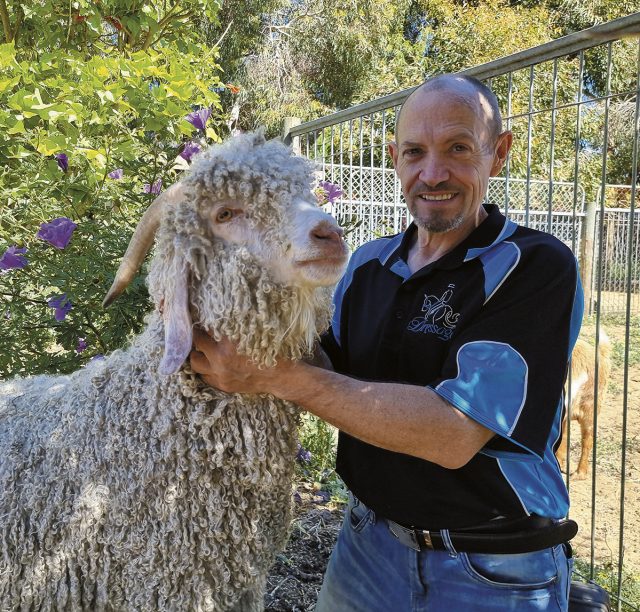Award-winning goat breeder Trevor Blight has been breeding goats for fifty years. In 2022, he came full circle, welcoming back Angora goats to join his flourishing Saanen dairy and Nigerian Dwarf goat herds at his Lower Chittering stud, Dandalee Park.
“My first goat was given to me when I was 10-years-old. It was a gift to my dad from a Polish family in Narrogin where we lived. It was a very generous gift and we accepted it – but we didn’t know what do with it!” Trevor laughs.
“We discovered Angora goats, which at the time were very rare. People were using other breeds with Angora bucks to upcross them, so we decided to do that and mated my pet doe to an Angora buck.”
This bountiful gift set Trevor, together with his mum Shirley, on a successful path of breeding and showing Angora goats during what was a boom time for the breed. When the Angora industry slowed, the pair turned their focus towards the Saanen dairy goat breed, and later the Nigerian Dwarf goat.
Dandalee Park was the first Australian breeder to purchase a 100% Nigerian Dwarf doe from original importers, First Fleet in Victoria. Since its introduction the Nigerian Dwarf breed has burgeoned.
“They are really popular, and it is one of the things I like about them — the demand,” said Trevor. “When breeding large dairy goats, there is a worry that you will have nobody to sell them to, and you don’t want to be breeding something that nobody wants. We have been fortunate to sell a lot to dairies overseas, but that market is hit and miss – it can go overnight.
“The local demand is quite limited for large dairy goats, but for miniature breeds it is huge and getting bigger and bigger! They have a big social media presence and we also find with our goats once someone brings them to the neighbourhood, everyone wants one!”
Trevor credits the Nigerian Dwarf breed with helping Dandalee achieve a highlight of their showing career, winning the Governor’s Cup at the 2021 Perth Royal Show – a presentation he almost missed as he was delivering a baby goat!
The Governor’s Cup is presented to the most successful exhibitor of livestock each year and Dandalee was the first goat breeder to achieve this honour.
“As a child, I grew up in awe of my grandfather’s success exhibiting sheep every year, and the Governor’s Cup was his ambition also. As successful as he was, he never quite achieved it.
“It had been a dream of mine to win, but with many large-scale farming dynasties exhibiting cattle, sheep, horse and alpacas I wasn’t confident we could do so. It was both a wonderful honour and privilege to win.”
While more than content with his successful stable of dairy and miniature goats, Trevor says, “It was always in the back of my mind that I would love to have Angoras again.”
Having kept an eye on the breed over the years, in February this year he imported top quality foundation Angora stock from South Australia and New South Wales.
The Angora goat is best known for its mohair fleece – a wool-like fibre, not to be confused with Angora wool, which comes from Angora rabbits and has highly-questionable production and harvesting methods.
The properties of mohair change as the goat ages. A young goat produces fleece averaging approximately 23 microns in diameter, which is primarily used for knitwear items. Fleece from an adult Angora averages a diameter around 38 microns and is used in upholstery and rug manufacture.
All mohair is incredibly durable and possesses the all-weather qualities of most wool, being warm in winter and allowing breathability in summer. Trevor is keen to raise the profile of these placid creatures who, with their friendly faces and soft fleece falling in ringlets like they just stepped out of salon, could easily compete with the Nigerian Dwarf for influencer status!
Mohair fleece is also achieving record prices – the Australian Mohair Marketing Organisation reported an Australian record average price of $34.65 /kg in April this year, which was $4.60 higher than the previous best auction average.
“Angoras could be much more successful if they got the publicity,” said Trevor. “I think because most mohair is sold overseas, it only takes one big market to stop — or fashion to change — for it to slow right down. That can put people off.
“And they do need management, shearing twice a year — it is difficult finding shearers that want to shear them, as they are harder to shear than a sheep. They are more agile and there’s not as much lanolin in the fleece, so the shearers handpiece can get hot.”
Dandalee took their Angora goats to the Gidgeannup Show on October 29 – the first time in more than a decade that Angoras have been displayed – and came away with the Champion Exhibit and Reserve, and Champion and Reserve Mohair Fleece awards.
Rounding out a stellar breeding and show year for Dandalee, Trevor also welcomed a set of quintuplet doe Nigerian Dwarf kids — five sisters from one mother, in one kidding. He says, “It’s very rare indeed — and like winning the lottery!”
Dandalee Park welcomes enquiries from the public and is happy to share their enthusiasm and expertise for all things goat-related! You can follow them on Facebook @DandaleeParkDairy Goats.








